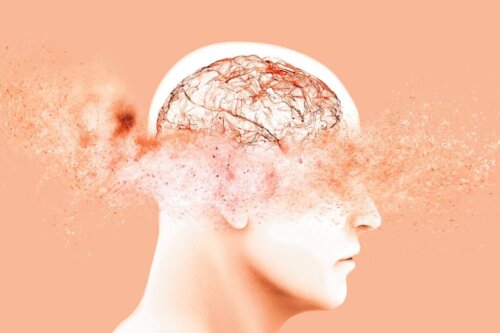In the US, the average life expectancy for men is 73.2 years, and for women 79.1 years. We know that, as the life expectancy of a country increases, its population ages more. However, this doesn’t necessarily mean that it ages better. In this article, we ask why dementia is on the increase. It seems that, while age is a key factor, it’s not the only one.
In 2015, there were 46.8 million people with dementia in the world. It’s estimated that by 2050 there’ll be 135 million sufferers. In fact, dementia is considered one of the main causes of disability and mortality in the world. In 2016, it was the fifth cause of death worldwide.
“$321 billion is the projected national cost of care for people with Alzheimer’s and other dementias.”
-The Alzheimer’s Society-
Dementia
Dementias are neurocognitive disorders. The clinical entities in this group are characterized by a deterioration of mental capacities, with sufficient severity to affect social and professional functioning.
“Dementia is an organic mental disorder of multiple etiology that gives rise to cognitive deficits, as well as changes in the subject’s behavior, which limit the performance of an autonomous and independent life.”
-Fernández-Calvo-
The World Health Organization (WHO) defines dementia as producing:
- Memory impairment. Sufferers experience an alteration in their ability to register, store, and remember information. This loss of information also relates to their family and their past.
- The deterioration of thinking and reasoning. The flow of thoughts and ideas is reduced. The sufferer finds it difficult to pay attention to more than one stimulus at the same time or to move their attention from one stimulus to another.
The American Psychiatric Organization requires the presence of at least one of the following cognitive alterations for dementia to be diagnosed:
- Executive dysfunction. The deterioration of planning processes, sequencing, and abstraction.
- Language disorders. Aphasia or the inability to communicate through speech.
- Movement disorders. Apraxia or the impaired ability to carry out motor actions despite intact motor function.
- Perceptual disorders. A failure to recognize or identify objects, despite intact sensory function.

Factors that explain why dementia cases are increasing
As it’s the most widespread dementia, we’re going to talk about the risk factors behind Alzheimer’s disease (AD). In fact, this dementia represents 35 percent of all cases.
“The fact that people as popular as Ronald Reagan, Rita Hayworth, Adolfo Suárez or Pasqual Maragall have suffered from Alzheimer’s Disease has facilitated the disclosure of a moving reality, which was described for the first time (in 1906) in a woman of 51 years, by Alois Alzheimer”.
-Belloch-
Research has discovered certain risk factors that, by themselves, don’t explain the appearance of the disease. However, when combined, they give rise to an explosive cocktail that can trigger the fuse of Alzheimer’s.
Risk factors
- Age. This is the biggest risk factor. From the age of 60, every five years, the risk of dementia doubles. Thus, at the age of 60, one percent of people will suffer from Alzheimer’s, while at age 90, 28.5 percent will suffer from it.
- Sex. There are two women with Alzheimer’s for every man. This can be explained by the fact that the life expectancy of women is higher. Furthermore, it’s also linked to menopause. That’s because estrogens prevent the cell death characteristic of Alzheimer’s. However, with the arrival of menopause, this protection disappears.
- Genetics. They highlight the role of the PPA, PSEN-1, and PSEN-2 genes in the case of early Alzheimer’s (which occurs before the age of 65). While in late Alzheimer’s, APOE4 is more relevant.
- Tobacco. There’s a great deal of debate regarding the role that tobacco plays in the development of Alzheimer’s. Nevertheless, most experts agree that it’s a variable that makes individuals more vulnerable.
- Having relatives with Alzheimer’s. 40 percent of people with Alzheimer’s have relatives who suffer or suffered from it. In fact, having a relative with the illness increases the probability of suffering from it between two and seven times.
- Non-steroidal anti-inflammatories. It seems that the consumption of non-steroidal anti-inflammatory drugs could help reduce the symptoms of Alzheimer’s and maybe even prevent it. Research is currently ongoing.
- Cranioencephalic trauma. People who have the APOE4 gene have a lower response after trauma and a higher risk of dementia. Boxers are, unfortunately, the cases that most support this hypothesis.
- Education. It seems to be a protective factor against Alzheimer’s. That said, we must be cautious as it’s not really clear how it interacts with other variables . For instance, economic resources, which often give individuals access to food of better nutritional quality.
- Diet. The consumption of antioxidants, either in the diet or through supplements, seems to play a protective role.
Having an active brain prevents the development of cognitive impairment. So, read, learn something new every day, and solve puzzles. Keep your mind moving.
Why is dementia on the rise?
Why are dementia cases on the rise? Although increasing longevity is the factor that best explains the increase in cases of dementia, we mustn’t forget that there are others. For instance, cardiovascular diseases, nutrition, and physical and mental activity also have an influence. Fortunately, these are factors that we do have control over.
The post Why Dementia Is on the Increase appeared first on Exploring your mind.



















Comments